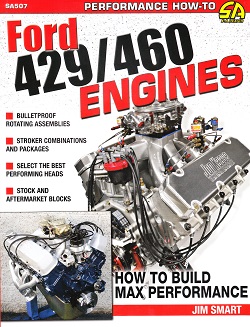How to Build Max Performance Ford 429/460 Engines
$24.95 WASWeight: 1.5 lbs.
Publisher: CarTech Books Inc. / SA Design
Softcover: 160 Pages w/ 355 Color Photos
Dimensions: 8.5 x 10.5 x 0.5 inches
FREE SHIPPING ON ORDERS $200+
How to Build Max Performance Ford 429/460 Engines
SYNOPSIS:
For years, Ford relied on the venerable FE big-block engine design to power its passenger cars, trucks, and even muscle cars—and why not? The design was rugged, reliable, amortized, and a proven race winner at Le Mans and drag strips across the country. However, as is always the case with technology, time marches on, and Ford had a new design with many improvements in mind. Enter the 385 family of engines (also known as the “Lima” big-block). Produced from 1968–1998, the 385-series engines were used in multiple applications from industrial trucks to muscle cars and luxury cruisers.
In How to Build Max-Performance Ford 429/460 Engines, which was written by Ford expert Jim Smart, all aspects of performance building are covered, including engine history and design, induction systems, cylinder heads, the valvetrain, camshaft selection, the engine block, and rotating assemblies. The best options, optimal parts matching, aftermarket versus factory parts, budget levels, and build levels are also examined. The 429/460 engines are a good platform for stroking, so that is covered here as well.
TABLE OF CONTENTS:
Acknowledgments
Introduction
Chapter 1: Building Basics
- Organization
- Parts Selection
- Compression Ratio
- The Physics of Power
- Wasted Power
- Building a 429/460 Stroker Engine
- Stroker Power Pointers
- Assembly Techniques
- Mock-Up Phase
- Ford Part/Casting Numbers
- Basic Part Numbers
- Date and Foundry Codes
- Ford Muscle Parts
- Good, Better, Best
- Controller Kit
- Dominator Kit
Chapter 2: The Block
- Aftermarket Blocks
- Budget Blocks
- Boss 429 Block
- Block Identification
- Block Preparation
- Fasteners, Clean Threads, and Torque
Chapter 3: Rotating Assembly
- Crankshaft Selection
- Forged Steel Crankshafts
- Crankshaft Differences
- Connecting Rods
- Rod Ratio
- Piston Selection
- Stroker Kits
- Building a Stroker
- Strength in Stud Girdles
- Harmonic Dampers and Flywheels
- Dynamic Balancing
Chapter 4: Lubrication
- Pump Blueprint Recipe
- Improved Oil Control
- Oil Pan
Chapter 5: Cylinder HeadsBoss 429
- Aftermarket Cylinder Heads
- Aftermarket 429/460 Wedge Cylinder Heads
- Head Work
- Valve Spring Pressures
- Spring Height
- Airflow
Chapter 6: Camshaft and Valvetrain
- Camshaft Technical Talk
- Street Camshafts
- Dual-Pattern Camshafts
- Racing Camshafts
- Why Degree a Camshaft?
- Timing Components
- Lifters
- Rocker Arms and Pushrods
- Valvetrain Geometry
- Rocker-Arm Adjustment
Chapter 7: Induction
- Carburetor Selection
- Carburetor Size
- Holley Carburetors
- Edelbrock Carburetors
- Carter Carburetors
- Demon Carburetors
- Quick Fuel Technology
- Weber Carburetors
- Bolt-on EFI
- Intake Manifold
- Quick Power
- Supercharging and Turbocharging
Chapter 8: Ignition
- Spark Knock
- Breaker Point Ignition
- Dwell Time
- Electronic Ignition
- Ignition Coils
- Distributor Types
- MSD Ignition
- Mallory Ignition
- Performance Distributors
- Ignition Wires
- Spark Plugs
- Charging System
- Starters
- Senders
Chapter 9: Exhaust
- System Sizing
- Secondary Tubes and Collectors
- Equal-Length, Step, and Tri-Y Headers
- Exhaust System Selection
- Stainless or Aluminized?
Chapter 10: Break-In and Tuning
- Break-In
- After Break-In
Chapter 11: Power Builds
- 429 Super Cobra Jet
- 460 Street/Strip Build
- MCE 598-ci T-Rex Build
- Defining Blueprint
- MCE T-Rex 598 on the Dyno
Appendix: Engine Math
Source Guide


 Cart
Cart


